Fig. 1.
Uptake of nutrients by intraerythrocytic Plasmodium, extracellular T. brucei, and intramacrophage Leishmania parasites. (A) Nutrient uptake by malaria parasites residing within the host red blood cell (RBC) entails flux of hydrophilic compounds across three membranes, the red blood cell plasma membrane, the parasitophorous vacuole membrane (PVM), and the parasite plasma membrane (PPM). The example of glucose uptake illustrates this pathway. Glucose is first imported into infected RBCs by the human glucose transporter GLUT1. It then probably diffuses across the PVM through a low-specificity PVM channel (31) and subsequently enters the parasite via the PPM transporter PfHT1, an ortholog of GLUT1. The new permeation pathway (NPP) channels are thought to be important routes of uptake for a variety of nutrients in the infected RBC (30) but probably do not mediate significant uptake of glucose. This figure was modified from Fig. 13.6 in reference 55 with permission of the publisher. (B) African trypanosomes reside in the mammalian host bloodstream or within interstitial spaces between cells and thus mediate uptake of nutrients from extracellular fluids employing parasite plasma membrane transporters (Tp). Examples of such transporters that have been well studied include those for hexoses, purines, and carboxylates (Table 1). This figure was modified from Fig. 2 in reference 104 with permission of the publisher. (C) Leishmania amastigotes live within parasitophorous vacuoles (PV) of mammalian host macrophages. Amastigotes may obtain nutrients by vesicular transport from the macrophage plasma membrane (88), from degradation products of macromolecules present in the PV lumen (a phagolysosome), or possibly from the host cell cytosol by flux across the PV (double arrows with question mark). Nutrients are imported into the amastigote by transporters located in the parasite plasma membrane. Examples of such transporters include those for hexoses, purines, iron, and polyamines (see Table 1).

